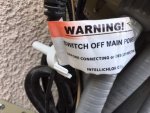Sorry, I didn't mean to make it sound like you've done anything wrong or bad for your SWG. I only meant if you left it unplugged, then you couldn't possibly, and wouldn't have to think about that aspect. Zero output is probably fine, but as you are just learning (or re-learning) how all that works, then you could play it safe.
Follow the SWG cable away from the SWG. At the end of that cable is a connector with a twist-type lock. It's either plugged into a transformer (big tan box), or your ET (bigger tan box). I have an external transformer, so I've never seen the plug go into an ET that has a built-in transformer, but it's there somewhere. You turn off anything that's running (pump, etc), then the breaker to the SWG (or all the breakers to the pad if you're not sure what all the breakers do), and then just twist the SWG connector and pull out the plug. Alternately, if your SWG is on a dedicated breaker (and you know that breaker doesn't supply power to anything else), then all you have to do is turn off the breaker.
That is the sure fire way that nothing you turn on, or schedule or adjust within the ET or ScreenLogic interface can inadvertently energize the plates of the SWG while the salt is still mixing. You tested salt at two different times, and found that it had gone down, right? That could be tester error, or margin of error, or just that you sampled two patches of water, one with more salt in it than the other, and that's what you're guarding against: two chunks of water running through your SWG, back to back, that have two different amounts of salt in them.
1. You switch to SWG in Pool Math when your pool is getting all its chlorine from the SWG, not before.
2. Wait a few days, and confirm your salt is mixed in: no salt on the bottom, consistent salt level test results from one day to the next.
3. Yes, add the CYA. Doesn't have to be slowly, unless by that you meant creep up on your target CYA amount cautiously, not to overshoot. Use your test kit and Pool Math to calculate how much CYA to add, then add half or 3/4 of that amount. Repeat until you reach your target. You just don't want to hit 90. Remember, you allow a day between dosing and testing, for the CYA to show up. Longer is better. Since both salt and CYA need this mixing time, you can do both simultaneously and use this "patience period" for both level adjustments.
4. That one I'm not sure of. Should be OK, or wait until someone else confirms that. Water with varying amounts of salt in it should not harm your heater (not like it would an SWG).


